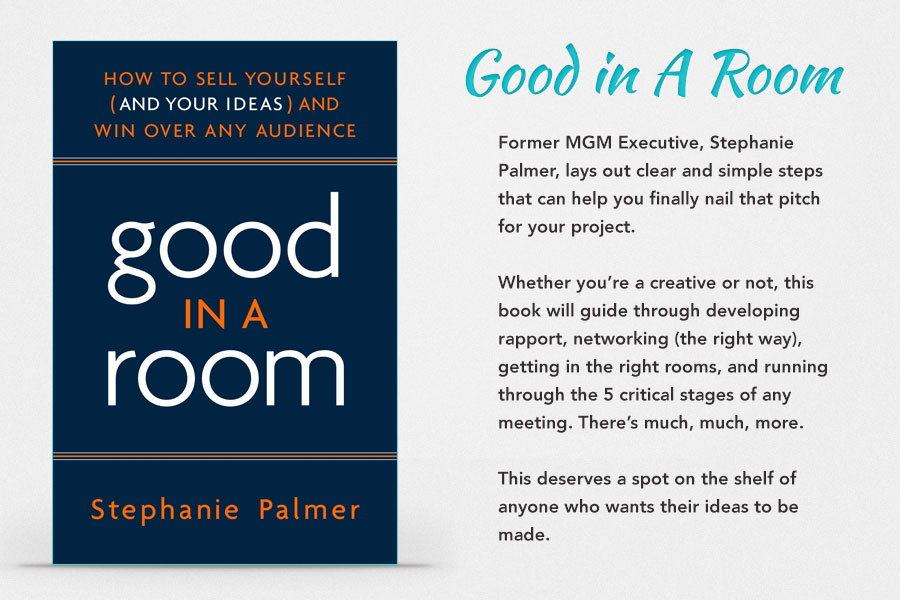In this blog post, I’m extremely happy to welcome Stephanie Palmer from GoodinaRoom.com to the Lawyers Rock website!
You have heard me talk about the importance of having a good pitch before but I wanted to bring a real expert on the subject to give you some more insight as to why it is so key to your projects success.
Stephanie is an expert at teaching people how to come up with the perfect Hollywood pitch before their big meeting with studio executives. So what qualifies her to teach this? I’m so glad you asked!
Stephanie is a former executive at MGM pictures and has listened to literally thousands of pitches from aspiring producers and writers. After being on the other side of the table for so many years she knows that often the pitch of an idea or concept is more important then the idea or concept itself to getting something greenlighted!
Stephanie has been involved in many great films like, Titanic, Legally Blonde and Enemy of the State, just to name a few. In 2005, Stephanie founded her consulting business GoodinaRoom to teach creative people how to pitch and sell their ideas. In 2008 she authored the book Good in A Room for that same purpose.
I had the pleasure of being introduced to Stephanie for the first time this January, and since then I’ve read alot of her stuff and quickly became a huge fan. She is one of the most genuine and authentic leaders in the entertainment information space that I know of, and within the first few minutes of this interview you’ll see just how great her information is and how sincere she is in trying to help creative people succeed.
With 2014 pitch season just around the corner, I wanted to bring Stephanie on the show to talk about how to really plan and come up with a great strategy for your pitch. And no surprise, Stephanie gives some of the best answers I’ve ever heard about these topics.
Enjoy the interview!
Richard:
Your expertise is in high demand in the entertainment industry. What was your inspiration for coming up with your business?
Stephanie
It was a combination of frustration and seeing an opportunity. As an executive, I was confident in doing certain aspects of my job, like finding material and working with writers. But there were other aspects, like handling production problems and political infighting that I didn’t like. Some people thrive in competitive situations and in emergencies, and I suppose I handled myself in those areas well enough, but I wanted to focus on the parts of my job where I felt like I was making more of a difference.
Then, I had this moment where I realized just how far apart the words of creativity and commerce really are – they’re both necessary, but it’s hard to bridge the gap. Writers need to learn how to speak in the language of business potential, and executives need to learn how to nurture emerging creative pros who are, in some sense, grabbing lightning with their bare hands.
Richard:
– You mention five stages of a pitch meeting in your book. Could you you please list them for the audience?
Stephanie
In Stage 1, Rapport, you build rapport and warm up the room.
In Stage 2, Listening, you ask questions and listen to show respect.
In Stage 3, The Pitch, you deliver the prepared component of your pitch.
In Stage 4, Q & A, you deliver the “improvised” component of your pitch.
In Stage 5, The Close, you ask for one thing if necessary and leave on a good note.
Richard:
– What can a presenter do to prepare for a pitch meeting?
Stephanie:
If there was one thing a person should do before a pitch meeting, it would be to pitch on video and watch yourself. You can’t help but notice things that need improvement. As a second tip, after you’ve pitched on video and (it’s painful, I know) watched yourself, take a practice meeting. By that I mean, mimic the conditions of the actual meeting as much as you can.
Richard:
– What is the most common mistake you have seen presenters make in pitch meetings?
Stephanie:
Hyping their own ideas, typically by leading off by saying something like, “I’ve got this great idea….” or “This is a highly commercial concept with Oscar-winning potential….” In other words, they give themselves a compliment before starting the pitch. It’s as if you went to a restaurant, and when the server was putting a plate of food in front of you, he said, “This will be delicious and I’m sure you will enjoy it because it is AMAZING.” And if you’re sitting there, you’d be thinking, “Well, how about if I taste it and decide for myself?”
Richard:
– How long do you think a pitch should be?
Stephanie:
Well, to steal from Mark Twain, as short as it can possibly be, but no shorter. Blake Snyder once said that his favorite pitch was for the movie Blind Date. “She’s the perfect woman – until she has a drink.” A good pitch is like a good joke – it’s truthful, surprising, and there’s a moment where the listener “gets” it.
Richard:
– I’m sure you have seen a number of presenters stumble during their pitches. What have been some effective ways that presenters have recovered after a misstep. For example, if a presenter doesn’t know the answer to an executive’s questions.
Stephanie:
This seems really simple, but at the beginning of the meeting when you’re offered a bottle of water, take it. Then, if you stumble or need a second to collect yourself, take a sip. It’s an acceptable crutch we all use. Another good technique is just to rewind, apologize if necessary, and continue.
But really, it’s not about tactics here so much as the general level of confidence you have. If you know what you’re doing in the room, making a mistake is no big deal. You just roll right over it. But if you don’t know what you’re doing, then making a mistake can feel like the end of the world, and then to a certain extent, it is.
Richard:
– Do you think that visual aids are helpful or a distraction when pitching?
Stephanie:
For a director, or for a reality TV show producer, they can be necessary. A director needs to prove the validity of his or her creative vision, and a visual aid can help do that. For a reality TV producer, it’s required. But for a writer, I’m against it.
In the idea selection stage, pictures of your vision can work against you because they constrain the decision-maker’s imagination.
If you say, “a handsome man steering a boat down a river,” listeners supply the details that work best for them. If you show them a picture of Adrien Brody canoeing down the Amazon… you better hope that they love Adrien Brody and the notion of filming in South America.
I think it’s better to work in words and let the listeners imagine what works best for them.
Richard:
– What does someone do who has created the perfect 30-minute pitch, but, due to circumstances, is only given 3 minutes to pitch?
Stephanie:
That’s a good question because I think a lot of writers feel like they have this problem. The first step is to recognize that no one wants to hear a 30-min pitch. Most decisions are made within the first minute. That’s why a good pitch should kick off with a summary of the core story that’s 1-3 sentences long.
It’s like, if a writer has a feature script that’s 500 pages long, he or she needs to cut it down to 120. How? Well, the usual way. That is to say, by honing the story, focusing on the theme, eliminating non-essential elements – basically killing your darlings. It’s painful, but sometimes, that’s writing.
Richard:
– What have you found to be an effective way that presenters have ended pitch meeting?
Stephanie:
I think presenters just need to stay tuned in and the executive will typically end the meeting, but if a presenter needs to leave, I would just thank the exec for his or her time and be on your way.
Richard:
– and, what do you think is an effective way to follow up a pitch meeting?
Stephanie:
Send a thank you note within 24 hours, then if you haven’t heard anything, email a week after that, and if you still haven’t heard anything, call a week after that. The really important thing, however, is to have another project you’re working on. So while you may be waiting for 2-3 weeks for a phone call, you’re busy developing something new.
I hope you found this great information from Stephanie useful! I have talked in the past on this blog about how important a good, solid pitch is to the success of your project but Stephanie goes really deep into the details of what makes a good pitch.
If you want to find out more about how to pitch please visit her at her site -> goodinaroom.com
If you want to check out her excellent book and learn how to sell yourself to any audience, click on the image below.
What did you think of Stephanie’s interview? Is coming up with a great pitch something you have struggled with? Or have you reached that point in the process yet? Would love to hear your take on this.
Take care, Richard.



10 Comments
[…] few weeks back I posted an interview with my friend Stephanie Palmer from GoodInARoom.com. Stephanie is a former film executive for MGM […]
[…] in a Room is run by my friend Stephanie Palmer and I have interviewed her in the past which you see here. But today was my first chance to sit down one on one with Jason Brubaker from Filmmaking Stuff who […]
[…] decision makers?” When it comes to the first question, I have done multiple posts, including here and […]
[…] mostly stemming from discussions with colleagues in the industry, including this interview with Stephanie Palmer and this one with Jenean Atwood […]
[…] she has been a frequent guest on my blog before including this full interview I did with her on the art of pitching to Hollywood […]
[…] met Stephanie Palmer earlier this year and I was immediately impressed with her knowledge and approach to the […]
[…] For some great tips on pitching check out this article. […]
[…] How to Come Up With The Perfect Hollywood Pitch – With Stephanie Palmer […]
My question is, how do you even get an interview for a pitch with an exec? I do not live in L.A. or New York but I have an idea and wanted to know how I can get an interview with an exec living in another state.
Great question! I think it requires networking and persistence. Many people start by attending tv conferences where these execs are present, such as ReelScreen West which starts tomorrow in LA. You will have to travel to NY or LA but you don’t have to live here. .There are other good ones to seek out like NATPE.